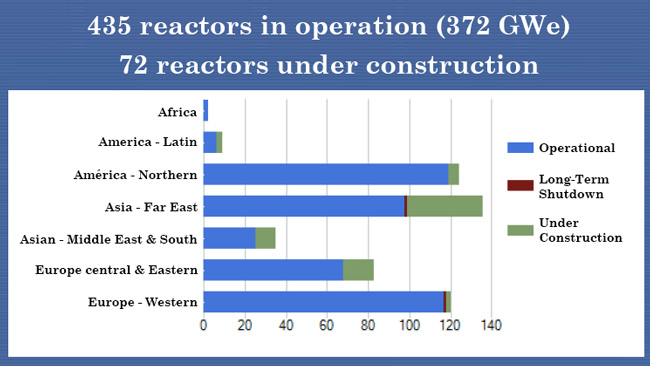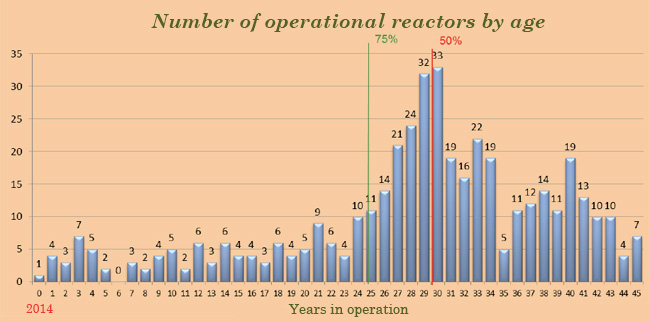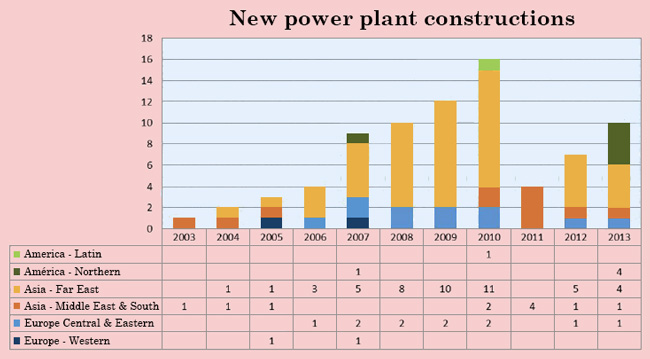A development that takes place today in Asia
At the beginning of 2014 the number of reactors in operation was 435 worldwide. These reactors provided a power of 372 Gigawatts-electric (Gwe), one GWe providing electricity to around one million people in a developed country.
In 2019, according to the World Nuclear Association, nuclear reactors produced 2,657 TWh worldwide (one TWh or terawatt hour equals 1 billion kilowatt hours), 95 TWh more than in 2018. This growth was localized in Asia (+90.5 TWh). Elsewhere in the world, production varies slightly.

Status of world reactor fleet in 2014
North America, Europe, Far East with Japan, Korea and China have the majority of these reactors. Most of the new reactors today are in Asia, particularly in China and India.
© Source AIEA
The United States have the largest and oldest nuclear fleet, with more than 100 reactors. The other main fleets are in Western Europe, in France with 58 reactors, in Russia and in the Far East with Japan and South Korea. In recent years China and India joined this group, while in Europe Germany closed its reactors.

Ages of reactors in operation (2014)
Most of the reactors built in the United States, Europe and Japan date from the 1970-80 period. In France, the oldest reactors has reach ed 40 years of age in 2019. In the United States, 38 units had already exceeded this age in 2014. Their existence was extended following a renewal of their operating license after severe scrutiny by the Nuclear Regulatory Commission (NRC).
© Source AIEA
Most reactors built in the United States, Europe and Japan date from the 1970s-80 period. The United States was the first to develop nuclear energy, but this development was stopped after the Three Mile Island accident and the Carter doctrine. The bulk of US reactors were over 40 years old in 2014. However, construction has started on a few reactors after a long interruption. England, once a pioneer in the field with around 10 old design reactors, is constructing an EPR at Hinkley Point.
France, on the initiative of Presidents Pompidou and Giscard d’Estaing, has built 58 pressurized water reactors. The commissioning of these reactors was spread over 1978 and 1997. The oldest of these reactors, that of Fessenheim in Alsace, which was in good condition at the age of 40, was closed in 2020, essentially for political reasons.
Russia and Eastern Europe countries have reactors inherited from the former Soviet Union. RBMK reactors similar to Chernobyl were gradually closed and replaced by pressurized water VVER reactors. Russia is also the only country to have a powerful fast neutron reactor.
After the United States and France, Japan has the third most important park, 54 nuclear reactors before March 2011 and the Fukushima accident. The Japanese government was in favour of restarting certain reactors. In 2016, about 42 reactors were likely to restart, but only six units having been authorized to do so by the safety authority. In the meantime, the share of fossil fuels (oil, gas) in electricity production has increased from 62% to 83% between 2010 and 2015.

Construction of new reactors
Reactors constructions have resumed since the 2000s. This recovery is mainly in Asia and particularly in China because of the enormous energy needs of a booming country. These constructions were slowed down by the Fukushima accident in 2011, but then picked up again.
© Source AIEA (2014)
A restart in the construction of reactors is observed. This recovery is taking place mainly in China, whose energy needs are enormous. India, which currently operates twenty reactors, mainly heavy water CANDU technology, plans to increase its nuclear power from 3% in 2016 to 25% of the “energy mix” in 2050.
In aging Western countries, new reactor construction is minimal to non-existent. While nuclear power could help limit global warming, leaders prefer to ignore it under pressure from the media and public opinion. However, as long as one do not know how to store the intermittent energy provided by wind and solar power, battalions of gigawatts without CO2 from nuclear power and dams would need neither wind nor sun. (Germany, which is closing its power stations, used dust-polluting coal-fired power stations).
The first European EPR in Oklihuto in Finland started in December 2021. In France, that of Flamanville is still under construction. The Finnish EPR arrived after the two EPRs built in China, currently in operation in Taishan.
Other articles on the subject « Nuclear Reactors »
Reactor Families
A variety of designs : Natural uranium or enriched uranium as fuel There are several industrial t[...]
Generation I reactors
1950-1970: First generation of reactors (50 – 500 MWe) The first generation reactors were i[...]
RBMK reactors
Soviet-era reactors at Chernobyl Cold War and the Iron Curtain led after 1947 to the development [...]
Generation II Reactors
1970-2009: the rise of nuclear energy About 85% of electricity produced worldwide by nuclear powe[...]
PWR Reactors
The most widespread type of reactor … Pressurised water reactors (PWR) are by far the most [...]
PWR Operation
High pressure water to evacuate heat and slow down neutrons The reactor core is the source of ene[...]
Boiling Water Reactors
BWR or Boiling Water Reactors Boiling water reactors or BWR are in operation in the United States[...]
Candu reactors
Canadian reactors using natural uranium and heavy water CANDU is a nuclear reactor brand develope[...]
Nuclear Propulsion
On-board reactors for submarines and aircraft carriers In addition to conventional land-based pow[...]